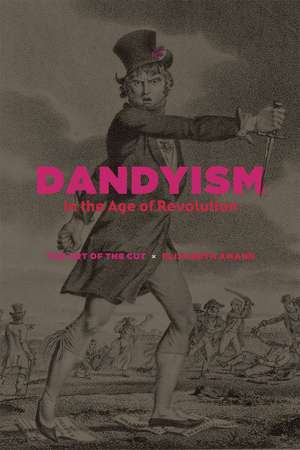Dandyism in the Age of Revolution: The Art of the Cut
Autor Elizabeth Amannen Limba Engleză Hardback – 7 ian 2015
From the color of a politician’s tie, to exorbitantly costly haircuts, to the size of an American flag pin adorning a lapel, it’s no secret that style has political meaning. And there was no time in history when the politics of fashion was more fraught than during the French Revolution. In the 1790s almost any article of clothing could be scrutinized for evidence of one’s political affiliation. A waistcoat with seventeen buttons, for example, could be a sign of counterrevolution—a reference to Louis XVII—and earn its wearer a trip to the guillotine.
In Dandyism in the Age of Revolution, Elizabeth Amann shows that in France, England, and Spain, daring dress became a way of taking a stance toward the social and political upheaval of the period. France is the centerpiece of the story, not just because of the significance of the Revolution but also because of the speed with which its politics and fashions shifted. Dandyism in France represented an attempt to recover a political center after the extremism of the Terror, while in England and Spain it offered a way to reflect upon the turmoil across the Channel and Pyrenees. From the Hair Powder Act, which required users of the product to purchase a permit, to the political implications of the feather in Yankee Doodle’s hat, Amann aims to revise our understanding of the origins of modern dandyism and to recover the political context from which it emerged.
In Dandyism in the Age of Revolution, Elizabeth Amann shows that in France, England, and Spain, daring dress became a way of taking a stance toward the social and political upheaval of the period. France is the centerpiece of the story, not just because of the significance of the Revolution but also because of the speed with which its politics and fashions shifted. Dandyism in France represented an attempt to recover a political center after the extremism of the Terror, while in England and Spain it offered a way to reflect upon the turmoil across the Channel and Pyrenees. From the Hair Powder Act, which required users of the product to purchase a permit, to the political implications of the feather in Yankee Doodle’s hat, Amann aims to revise our understanding of the origins of modern dandyism and to recover the political context from which it emerged.
Preț: 259.12 lei
Preț vechi: 304.86 lei
-15% Nou
Puncte Express: 389
Preț estimativ în valută:
49.58€ • 51.77$ • 41.04£
49.58€ • 51.77$ • 41.04£
Carte indisponibilă temporar
Doresc să fiu notificat când acest titlu va fi disponibil:
Se trimite...
Preluare comenzi: 021 569.72.76
Specificații
ISBN-13: 9780226187259
ISBN-10: 022618725X
Pagini: 288
Ilustrații: 23 halftones
Dimensiuni: 152 x 229 x 25 mm
Greutate: 0.54 kg
Editura: University of Chicago Press
Colecția University of Chicago Press
ISBN-10: 022618725X
Pagini: 288
Ilustrații: 23 halftones
Dimensiuni: 152 x 229 x 25 mm
Greutate: 0.54 kg
Editura: University of Chicago Press
Colecția University of Chicago Press
Notă biografică
Elizabeth Amann is professor in the Department of Literary Studies at Ghent University, Belgium. She is the author of Importing Madame Bovary: The Politics of Adultery.
Cuprins
List of Illustrations
Introduction
1. Muscadins
2. Jeunes gens
3. Incroyables
4. Currutacos
5. Crops
Epilogue
Acknowledgments
List of Abbreviations
Notes
Index
Introduction
1. Muscadins
2. Jeunes gens
3. Incroyables
4. Currutacos
5. Crops
Epilogue
Acknowledgments
List of Abbreviations
Notes
Index
Recenzii
“Dandyism in the Age of Revolution sweeps aside received notions of the dandy as a disengaged fop to recover the figure’s political and politicized origins. Well researched and historiographically informed, this book is leavened with the sort of wordplay that dandies themselves would have appreciated.”
"Elizabeth Amann's study brings to life the lost fashion world of young men in an age of Revolution. Arguing for a seismic shift in the meanings of men's dress in the late eighteenth century, Amann presents a new way of thinking about how the trauma of the French Revolution was managed through sartorial fashions."
“Very detailed and revealing. . . . Amann’s book luckily fills a gap and adds an important aspect to the evolution of dandyism, also providing valuable input for the French influence on the English dandy.”
“Amann’s fascinating examination of the late eighteenth-century cult of the ‘dandy’ might more accurately be entitled ‘Dandyism in the Literature of the Revolution,’ for it is in fact with the textual character of the ‘dandy’ that she is primarily concerned. Incorporating a vast array of literary genres, from plays, novels, poems, and other purely fictional forms, to ‘reports’ and reviews in pamphlets and newspapers that run the gamut from fictional to real, Amann’s probing analysis of the character of the dandy as he emerged in print treats fashion as a political language wielded and parried by innumerable writers in three European languages. Her study will thus appeal widely to scholars of comparative literature and history alike. . . . As an interpreter of texts . . . Amann is brilliant.”
“The self-fashioning by these figures and the conflicting ways in which they were represented in assorted newspaper articles, pamphlets, stage plays, and visual caricatures are analyzed in terms of what Amann calls three different kinds of ‘imagination’. . . . With impressive dexterity, she succeeds in identifying the ways in which these imaginations frequently overlapped without causing them to lose their pertinence. Her illustrative examples are both diverse and illuminating.”
“Amann’s new study examines this turbulent decade. Her book, intensively researched and well-illustrated with many fresh pictures, is the first on the subject. . . . As an exploration of the interaction of fashion and politics in the 1790s, Amann’s book is invaluable.”
“Rigorous and sophisticated.”
“A passionate read, an indispensable reference work and a valuable contribution to the social, political, and economic history of France in the revolutionary period and to its customs.”
